Description and Biology:
Size:Body Length: 100-150 cm / 3.3-5 ft.
Shoulder Height: 60-85 cm / 2-2.8 ft.
Tail Length: 10-17 cm / 4-6.8 in.
Weight: 25-35 kg / 55-77 lb.
Description: One of the few antelope which exhibits pronounced sexual dimorphism, the genders in the blackbuck are readily distinguishable. Both sexes have white underparts, including the insides of the legs and lower chest, as well as a white ring surrounding the eye and a white chin. Females and young are yellowish-fawn on their back and head, and are generally hornless. Males gradually darken from tan to deep brown or black with age, beginning after 2 years. The build is slender, and the tail short. The horns, found only in males and appearing before their pronounced colour change, are twisted in a tight spiral with up to five turns. Ridged laterally, they may grow 35-73 cm / 14-29 inches.
Reproduction: Gestation Period: 5-6 months. Young per Birth: 1 Although breeding can occur throughout the year, there are peak periods in March-May and August-October. Weaning: 5-6 months. Sexual Maturity: 1.5-2 years. Life span: 10-12 years, rarely up to 18.
Social Behavior: During the cooler seasons, blackbuck are diurnal, and active intermittently throughout the hours of daylight. As the temperature rises, however, they are more often seen grazing in the open in the early morning and late afternoon, sheltering from the sun for the rest of the day. When a potential threat is spotted, the alert females are usually first to sound the alarm, with one individual leaping into the air. This motion is followed by the entire herd, although after a few large bounds the herd reduces its pace to a normal gallop. One of the fastest land mammals, blackbuck have been clocked going in excess of 80 kmph / 48 mph.. During the breeding season males become territorial, defending an area usually ranging in size from 1 to 17 hectares from rival males, and attempting to keep the largest group of females within it for the longest period of time. This territoriality can last anywhere from two weeks to eight months. Mixed herds with 5-50 animals, generally with three or fewer males. Bachelor herds are known. Dominance among males within a herd is achieved primarily with posturing and threatening gestures: fights with the sharp horns are rare.
Diet: Leaves, buds, grasses, field fruits. (all above information from "The Ulimate Ungulate Page" by Brent Huffman).
Habitat and Distribution:
Blackbucks are native to India and Pakistan, where they were widespread in plains and open woodlands; western deserts, and northern mountains limited their distribution. Today, extensive hunting and habitat destruction have restricted blackbuck to only small, isolated populations in their former native habitat.In Pakistan the blackbuck lives in semi-desert areas, such as Cholistan and Thar. Today the blackbuck is an ocassional staggler along the eastern desert border areas of the country. There is no permant resident population today in Pakistan. During the late 1970's and early 80's small populations of blackbuck were brought from Texas, U.S.A to start a reintroduction program in Pakistan. These projects have had some success and now there are small captive populations of blackbuck in 3-4 locations, particularly in Kirthar and lal Sohanra National Parks. The breeding success achieve at Lal Sohanra is 413 animals (Dr. A.Aleem,1998) where as from Khar time to time number of Black Bucks provided to the eminent conservationists for further propagation in their private reserve. At present about 500 animals are surviving in Mir of Khairpurs Mehrano reserve, 110 at Khangur, Ghotki and 70 at New Jatoi, Nawab Shah. However at Khar Center only 35 animals (R.A.Rajput 1999) remain. Except these, some are kept in different zoo's, wildlife centres and in possession of individuals. At present all together about 1500 Black Bucks are reared in captivity and they are surviving in Punjab and Sindh regions of Pakistan. These will be released in the wild in the near future.
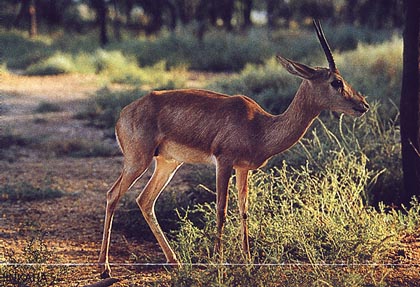
Description and Biology:
Size:Shoulder Height: 65cm. .
Weight: 23kg.
Description: The Chinkara, whilst resembeling closely the Goitred Gazelle in external appearance and colouring, is on average a slightly smaller animal. The principal differences related only to the absence of any enlargement or swelling in the larynx, differences in the pelage, and the development of the horns. In summer coat, the Indian Gazelle is of warm biscuit, or reddish-buff colour, with the fur smooth and highly glossy. Even in winter coat the white belly and throat fur is smooth and short in contrast to that of the Goitred Gazelle. The tail is medium long and covered with a dorsal crest of black hairs. There are indistinct horizontal and pyreal stripes bordering the flanks and caudal areas in summer coat. The sides of the face are also patterned with broad dark chestnut stripes from the corner of the eye to the muzzle bordered above and below by white stripes. The average horn length of males is 25.5-30.5 cm (10-12 in) measured over the curve, with record horns reaching just over 39cm (15.5in).
Reproduction: Weaning: At about two months. Sexual Maturity: At two years of age. Life span: Unknown. Gestation Period: About five to five and a half months. Young per Birth: Generally 1, but twins have been reported quite frequently. In Pakistan, the rut appears it occur in two seasons, one lasting from the end of monsoon up to early October and again in the late Spring from March to the end of April. The births occure mainly in April.
Social Behavior: In its wide roaming habits, tendency tom keep to small groups of two to three individuals and its general alertness, the Chinkara is very similar to the Goitered Gazelle. The Chinkara is almost wholly nocturnal in foraging activity, though they will emerge to start feeding before sunset.
Diet: Chinkara's are adapted to browsing and they will browse on various bushes and green twigs. They also take leaves of different plants and can go without water for days (all above information from "The Mammals of Pakistan" by T.J Roberts) .
Habitat and Distribution:
A very adaptable animal , it seems to be able to exist in extensive sand-dune areas down to sea level as well as in stony plateaus and low hilly regions up to 1,500m elevation. The Chinkara is severly reduced in numbers, perhaps to the point of extinction, in the desert regions of all along the eastern border of Pakistan. It is not however , in danger of extinction in the country as a whole, because it is so widespread and also lives in rocky escarpment areas. The Chinkara is now rare in the Thal desert. They survive in good numbers in Sibi plains, Mekran, Turbat and Lasbela in Baluchistan. They are also found in Kirthar hills and also in Margalla hills, but numbers in Margalla hills are believed to be very small. Isolated populations are also found in Salt Range, Kala Chitta hills and Cholistan in Punjab and Thar desert in Sind. A helicopter survey conducted in November 2000 by the staff of the Sindh Wildlife Department, Zoological Survey Department and the University of Melbourne yielded estimates of the total populations of the Chinkara at 1060 ± 580 in Kirthar National Park. Chinkara's are ruthlesly hunted by local people and hunters and this has resulted in the reduction of once plentiful population in Pakistan
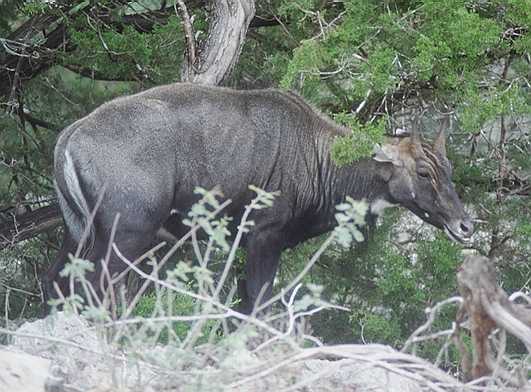
Description and Biology:
Size:Body Length: 180-200 cm / 6-6.6 ft.
Shoulder Height: 120-150 cm / 4-5 ft.
Tail Length: 40-45 cm / 16-22 in.
Weight: 120-240 kg / 264-528 lb.
Description: The largest of the asian antelope, the nilgai was first described by Pallas in 1766. The short coat is yellow-brown in females, and gradually turns blue-grey in males as they mature. There is an erectable mane on the nape and back and a "hair pennant" in the middle of the underside of the neck. There are white markings in the form of cheek spots, edges of the lips, and a throat bib. Along the underside is a thin white stripe, which "balloons" at the rear. The slender legs support a stocky body, which slopes downwards towards the rear. The head is long and slender. Males have 20-25 cm / 8-10 inch long horns which are straight and tilted slightly forwards.
Reproduction: Weaning: By 10 months. Sexual Maturity: Around 18 months. Life span: Up to 21 years. Gestation Period: About 8 months. Young per Birth: Generally 2 (over 60% of births), sometimes 1 or 3. Breeding occurs throughout the year, but the peak of mating is December-March, with the resulting calves born in September and October.
Social Behavior: The nilgai is mainly diurnal, with peaks in activity in the early morning and late afternoon. The sense of sight is well developed among this wary species. When chased, nilgai can run up to 48 kmph / 29 mph. Males have been observed to establish territories during the breeding season, attempting to gather and keep small herds of females (up to 10) within their area. Males compete with each other with threatening posture displays and neck wrestling, rarely leading to both rivals kneeling and lunging at each other with their horns. Normally silent, nilgai have been recorded making a roaring vocalization. The population density in central India is about 0.07 animals per square kilometer. Single sex or mixed herds of 4-20 individuals, old bulls may be solitary.
Diet: Leaves, buds, grasses, fruit. (all above information from "The Ulimate Ungulate Page" by Brent Huffman).
Habitat and Distribution:
The Nilgai's preferred habitat is grassy steppe and woodlands area. In Pakistan this Antelope is mainly found in extensive Desert regions, such as Cholistan in Punjab and Thar in Sind. Today the Nilgai is mainly found along the Indo-Pak border in the eastern part of the country. Here they are normaly found solitary. The Nilgai is also found in Changa Manga Plantation near Lahore. Unconfirmed report also come from Azad Kashmir, but the numbers here are thought to be very low. 220 Nilgai were counted in 1999 by the Sind Wildlife Department in the district of Tharparkar.The Nilgai is now rare in the country, but reintroduction programs are in place and it is hoped that these will be released in the wild to secure the few remaining herds.
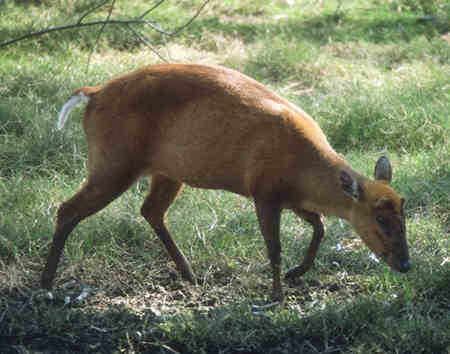
Description and Biology:
Size:Shoulder Height: 1 foot 8 inches to 2 feet
Weight: 45 lbs
Description: Barking deer are the smallest in size of all deer. The stags have very small antlers, not more than 4 inches long, with short brow lines and straight, unforked beams which grow backwards. Their coat is bright chestnut and their gait are unlike that of the hog deer, with heads down and stiff-legged.
Social Behavior: On hearing their name -- Barking Deer -- one may be prompted to ask whether this deer can bark like a dog. The name `barking deer' was given to them for their loud, sharp calls resemble the barks of dogs. Besides this loud and sharp "bark", this deer also produecs an indistinct rattling sound when running. Barking deer live mostly in pairs. Come the mating season, the adult males fight their rivals. In so doing, they use their sharp-pointed antlers and razor-sharp canine teeth, badly wounding each other. do.
Diet: Browser and grazer . (all above information from Shangri La home page).
Habitat and Distribution:
Browsers and grazers, barking deer are found in both sal and riverine forests, but in Pakistan this little deer is found in a very limited mountanious area. This deer is mainly found in the Margalla Hills. It is also found in very few numbers in Azad Kashmir. The main threat to this deer's survival is loss of habitat, which is so limited in Pakistan. Uncontrolled livestock grazing may lead this beautiful deer to the verge of extinction. It's only future survival is in the Margalla Hills National Park, where there still may be 30-40 barking deer
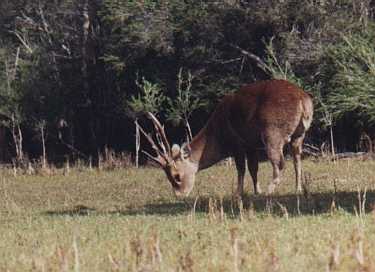
Description and Biology:
Size:Shoulder Height: over 2 feet
Weight: 75 to 120 lbs
Description: The Hog deer is a close relative of the Axis deer or Chital, which is now extinct in Pakistan, but is found in neighbouring India. Adult Hog deers have a brown coat that gets darker in winter. Though spotted with indistinct spots, hog deer don't have as bright and conspicuous spots as spotted deer (chital) do. The older hog deers get, dimmer the spots become. Hog deers have slender, three-tined antlers rising from bony pedicals; the browline making acute angles with the main beam.
Reproduction: The peak of rut season comes during the monsoon and the hind gives birth to one calf at a time
Social Behavior: This species of deer is marked by thick set-appearance and peculiar gait. Reminiscent of the pig, as their name suggests, hog deer are a strange kind of deer that run with the heads down and at times collide with other fellow deers. They prefer to creash shurbs and undergrowth rather than jumping over them as other deers. Hog deer are particularly found fewer in group, but on occasions they can be seen in herds of ten or more. do.
Diet: Being predominantly grazers, they prefer short grasslands nearby riverbankds and swamps. (all above information from Shangri La home page).
Habitat and Distribution:
The Hog deer's prefered habitat is grasslands or swamps near rivers. In Pakistan it is mainly found in Riverian forests of river Indus in Lower Sind. The Hog deer is found in the east Nara and the indus delta forests in the extreme south of Sind. Due to the controlling of river Indus by building dams and barrages the habitat of Hog deer has greatly been reduced to one or two pockets. It is also hunted extensively by hunters and the local people. The result is that it has become extremly rare and is now on the verge of extinction.
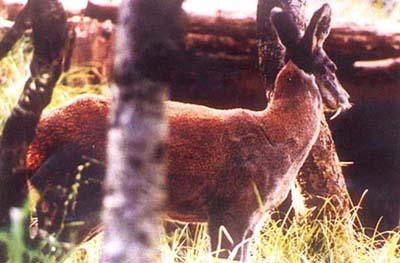
Description and Biology:
Size:Body Length: 86-100 cm / 2.8-3.3 ft
Shoulder Height: 51-53 cm / 20-21 inches
Tail Length: 4-6 cm / 1.6-2.4 inches
Weight: 11-18 kg / 24-40 lb
Description: The general colour of the coat, composed of brittle hairs, is a slightly grizzled brown. As the name suggests, on the chest is a wide vertical whitish-yellow stripe which extends up the throat to the chin. The ears are tipped with yellow hairs. The body slopes forward, as the hind legs are almost one third longer than the forelegs, causing the height at the rump to be almost 10 cm / 4 inches above the shoulder. The ears are large and rounded, generally lined with whitish fur. Both sexes have well-developed upper canines, and in males these may reach a length of 7 cm / 3 inches and protrude from the mouth in a fang-like manner. The canines are constantly growing, but, due to their mobility and fragility, they are easily broken. There are no antlers as in other deer species.
Reproduction: Weaning: 3-4 months. Sexual Maturity: 18-24 months. Life span: 12-20 years. Gestation Period: 6.5 months. Young per Birth: 1, sometimes 2. Breeding occurs primarily in November-December, with the resulting being born from May to June. After birth, the young deer lie hidden in secluded areas, essentially independent of their mothers except at feeding times. This hiding period may last up to 2 months.
Social Behavior: Himalayan musk deer are most active between dusk and dawn, alternately resting and feeding throughout this period. At night, musk deer can be seen in the open areas of their habitat as they graze, while during the day, they remain in dense cover. Neighbouring individuals may utilize common latrines, an activity with becomes more frequent during the mating season. Himalayan musk deer are sedentary, remaining wthin a defined home range throughout the year. In females these are about 125 acres in size, while male musk deer will control a territory which encompasses the ranges of several females, defending it against intrusion by rival males. The Himalayan musk deer does not undertake any seasonal migrations, remaining in the same area year-round despite harsh weather conditions. A shy animal, the musk deer depends on its sense of hearing to locate sources of danger. When frightened, they make broad leaps, each measuring up to 6 meters / 19 feet in length. Drastic changes in direction are made during flight, and every few jumps the animal will stop and listen. Communication between individuals is thought to be based primarily on their sense of smell, due to the high development of the glands of musk deer. Primarily silent, musk deer will emit a loud double hiss if alarmed, and may scream plaintively if wounded. Population densities are about 3-4 animals per square kilometer. Musk deer are normally found solitary.
Diet: A wide variety of vegetation, such as grass, moss and tender shoots. In winter, twigs, buds and lichens are taken. (all above information from "The Ultimate Ungulates Page," by Brent Huffman and WCMC/WWF ).
Habitat and Distribution:
Himalayan Musk deer are found in alpine forest and scrub at elevations of 2,200-4,300 meters / 7250-14,200 feet on the southern slopes of the Himalayas. In Pakistan the Musk deer is found in the remote higher mountain regions of Gilgit, Baltistan, Upper Swat and Hazara. The musk deer is also found in the Deosai National Park. It is rare in all of these regions because of relatively unfavourable habitat. But the main reason for its rarity is due to persecution from local hill people for its musk gland, which is used extensively in the manufacture of perfume, soap, and medicinal preparations. The musk produced by this genus of primitive deer is highly held for its cosmetic and alleged pharmaceutical properties, and can fetch U.S. $45,000 per kilogram (2.2 pounds) on the international market. Although this musk, produced in a gland of the males, can be extracted from live animals, most "musk-gatherers" kill the animals to remove the entire sac, which yields only about 25 grams (1/40 of a kilogram) of the brown waxy substance. Because of the demand for this substance, musk deer have been wiped out in parts of their range. Traps set for male musk deer often kill females or young. This endangered deer is still not protected in Pakistan.
Local name: Hiran (Urdu)
Description and Biology:
Size:Body Length: 90-115 cm / 3-3.8 ft
Shoulder Height: 60-80 cm / 2-2.6 ft
Tail Length: 15-20 cm / 6-8 in
Weight: 18-33 kg / 40-73 lb
Description: The light brown body darkens towards the belly, where it joins with the white underparts in a crisp line. The typical facial marking of gazelles are pronounced only in juveniles - with age the forehead and nose bridge turn white, with only the brown eye-nose stripe remaining. The tail is black in colour, conspicuous against the white buttocks when raised in flight. Unlike the rest of the "true gazelles", only the male goitered gazelle carries horns, which grow 25-43 cm / 10-17.2 inches long. Black in colour and sharply diverging, the horns form an "S" shaped, bending up backwards, and turning in at the tips. During the rut, the larynx of males bulges outwards, resembling a goiter.
Reproduction: Gestation Period: 5-6 months.Young per Birth: 1 or 2, rarely up to 4. Unlike many gazelles, the goitered gazelle has a restricted breeding season. This occurs from November to January, with the resulting births taking place in April and May. The young lie camouflaged away from their mothers for the first 2 weeks, gaining strength and stability on their wobbly legs. The mother generally returns to nurse three times each day. Weaning: After 4-5 months. Sexual Maturity: Females at 9 months, males around 18 months
Social Behavior: During the summer, most activity takes place in the late afternoon and early morning, consisting of leisurely walking and simultaneous grazing. At midday, herds take shelter in the shade, where they excavate shallow oval-shaped pits to lie in. During the cooler winter months, this midday break is significantly reduced, and sometimes even eliminated. If disturbed from its shelter, a goitered gazelle rapidly flees for 200-300 meters, pausing to assess the danger from this distance. A broad circular path is then taken back to the original resting spot. Extremely speedy, these gazelles can run up to 60 kmph / 36 mph. Each animal generally consumes about 30% of its body weight in green matter per day, and can derive most of its needed moisture from it. In the spring and summer, groups may travel to water sources, but even still they rarely drink daily. Herds cover 10-30 kilometers per day in the winter, with these distances being reduced nearly tenfold in summer. Throughout much of their range, goitered gazelles undergo a seasonal migrations. During the breeding season, adult males become territorial, using dung middens placed at strategic locations to indicate ownership. At this time, males emit hoarse bellows, and glandular activity increases significantly, with the result that the male is often seen smearing secretions on objects. Family group: In summer, small family groups of 2-5 animals; In winter, large herds with dozens or even hundreds of individuals.
Diet: Grasses, leaves, and shoots.
Habitat and Distribution:
The Goitered Gazelle inhabits the semi-desert and desert steppe in the West of Baluchistan. It survives in the Chagai hills and Nushki hills south west of Quetta. Goitered Gazelle are also found at Chaman, near the border with Afghanistan. This gazelle is very rare and local in distribution in Pakistan. Depite this fact, it is hunted by local people and by visiting Arab hunters, who come each year to hunt Houbara Bustard. Because of this it is declining in number and will become extinct if hunting is not stopped in these regions.